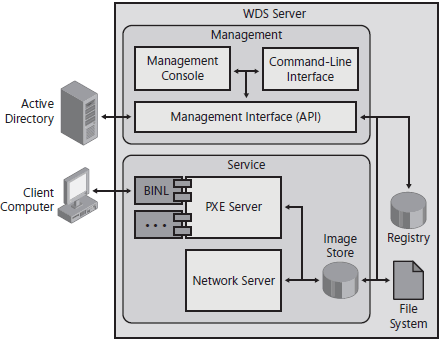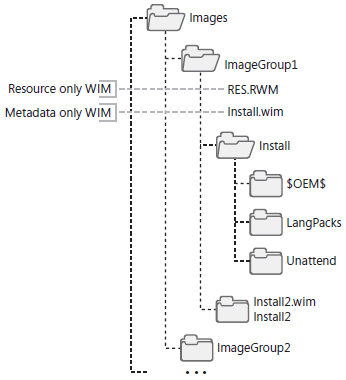Service Architecture
The Windows Deployment Services architecture has three major categories of features:
- Management features Management features are a set of tools that you use to manage the server, operating system images, and client computer accounts. The Windows Deployment Services MMC snap-in is a management feature, and the command-line interface is another.
- Server features Server features include a PXE server for network booting a client to load and install an operating system. Server features also include a shared folder and image repository that contains boot images, installation images, a Trivial File Transfer Protocol (TFTP) server, a multicast server, a driver provisioning server, and files that you need specifically for network boot.
- Client features Client features include a graphical user interface (GUI) that runs within Windows PE and communicates with the server features to select and install an operating system image.
Figure below illustrates the various features of Windows Deployment Services. The following sections describe the image store, PXE server, management, and client features in more detail.

Image Store
Figure below describes how Windows Deployment Services organizes the image store.

Organizing images into groups, as shown in above, provides two benefits. First, image groups allow you to better manage and organize images. For example, you can manage the security of an entire image group rather than managing the security of individual images. Second, image groups provide units of single instancing. This means that all the images within an image group use Single Instance Storage (SIS) to significantly compress their contents. The file Res.rwm contains all of the file resources for the image group, and this file uses SIS. Each image file contains only metadata that describes the image file contents based on the contents of Res.rwm.
Windows Deployment Services references images by their group name and image file name. For example, the image ImageGroup1\Install2.wim refers to the image file Install2.wim in the group ImageGroup1.
In this tutorial:
- Configuring Windows Deployment Services
- Introducing Windows Deployment Services
- Service Architecture
- PXE Services
- Operating Modes
- Legacy Mode
- Mixed Mode
- Native Mode
- Planning for Windows Deployment Services
- Choosing a Version of Windows Deployment Services
- New Features of Windows Deployment Services in Windows Server 2008 R2
- Server Requirements
- Client Computer Requirements
- DHCP Requirements
- Routing Requirements
- Capacity Requirements
- Installing Windows Deployment Services
- Windows Server 2003
- Windows Server 2008 R2
- Windows 7 Configuring Deployment Services
- Preparing Discover Images
- Windows Importing Images
- Importing Boot Images
- Importing Install Images
- Managing and Deploying Driver Packages
- Deploying Driver Packages to Clients Using Method 1
- Deploying Driver Packages to Clients Using Method 2
- Deploying Driver Packages to Clients Using Method 3
- Managing Driver Groups and Driver Packages
- Adding Driver Packages to Boot Images
- Managing Image Security
- Pre-staging Client Computers
- Configuring Administrator Approval
- Windows 7 Installing
- Capturing Custom Images
- Creating Multicast Transmissions
- Performing Multicast Deployment
- Using Windows Deployment Services with Microsoft Deployment Toolkit
